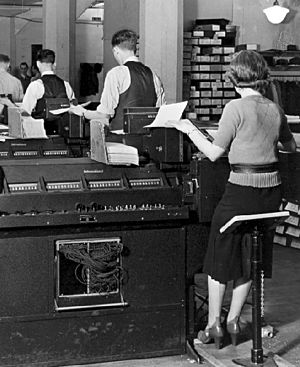Tabulating machine facts for kids
The tabulating machine was a special machine used a long time ago to help count and organize information very quickly. It was super important for big tasks, like counting all the people in a country for a United States census in 1890. This amazing machine was invented by a clever person named Herman Hollerith. Hollerith's machine worked by reading special cards with holes punched in them. These holes stored all the important information in a very organized way.
Contents
What Was a Tabulating Machine?
A tabulating machine was an early type of machine designed to process data. It could read, sort, and count information that was stored on punched cards. Think of punched cards like early computer memory. Each hole on a card represented a piece of information.
How Did It Work?
The tabulating machine used electricity to sense the holes in the cards. When a hole was detected, it would complete an electrical circuit. This allowed the machine to count specific pieces of data. For example, it could count how many people lived in a certain area or how many were a specific age.
The Role of Punched Cards
Punched cards were the key to how these machines worked. Each card could hold a lot of information in a coded way. Operators would punch holes into the cards using a special device. Then, these cards would be fed into the tabulating machine. The machine would then quickly read the holes and add up the numbers or sort the data.
Who Invented the Tabulating Machine?
The tabulating machine was invented by Herman Hollerith. He was an American inventor who worked for the U.S. Census Bureau. He saw how slow and difficult it was to count millions of people by hand. This led him to create a faster, more accurate method using machines.
Why Was It Invented?
The main reason Hollerith invented his machine was to speed up the 1890 United States Census. The previous census in 1880 took over seven years to complete by hand! Hollerith's machine helped finish the 1890 census in just two and a half years. This showed how powerful machines could be for handling large amounts of data.
The Impact of Tabulating Machines
Tabulating machines changed how governments and businesses handled information. They made it possible to process huge amounts of data much faster and with fewer mistakes.
Beyond the Census
After the census, tabulating machines were used in many other areas. Businesses used them for accounting, tracking inventory, and managing customer records. Railroads used them to keep track of tickets and freight. These machines were the start of modern data processing.
The Path to Computers
The ideas behind tabulating machines, especially the use of punched cards, were very important for the development of early computers. Companies like IBM, which was founded by Herman Hollerith, continued to develop these machines. They eventually led to the powerful electronic computers we use today.
Images for kids
See also
 In Spanish: Tabuladora para niños
In Spanish: Tabuladora para niños





